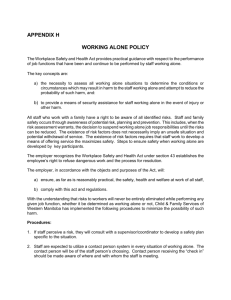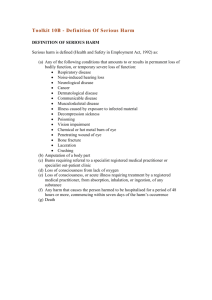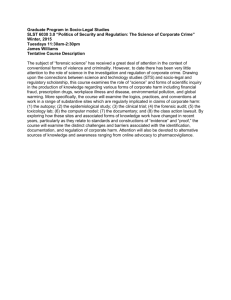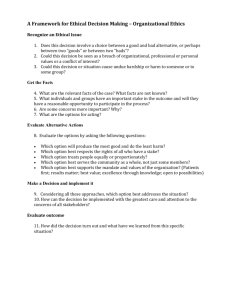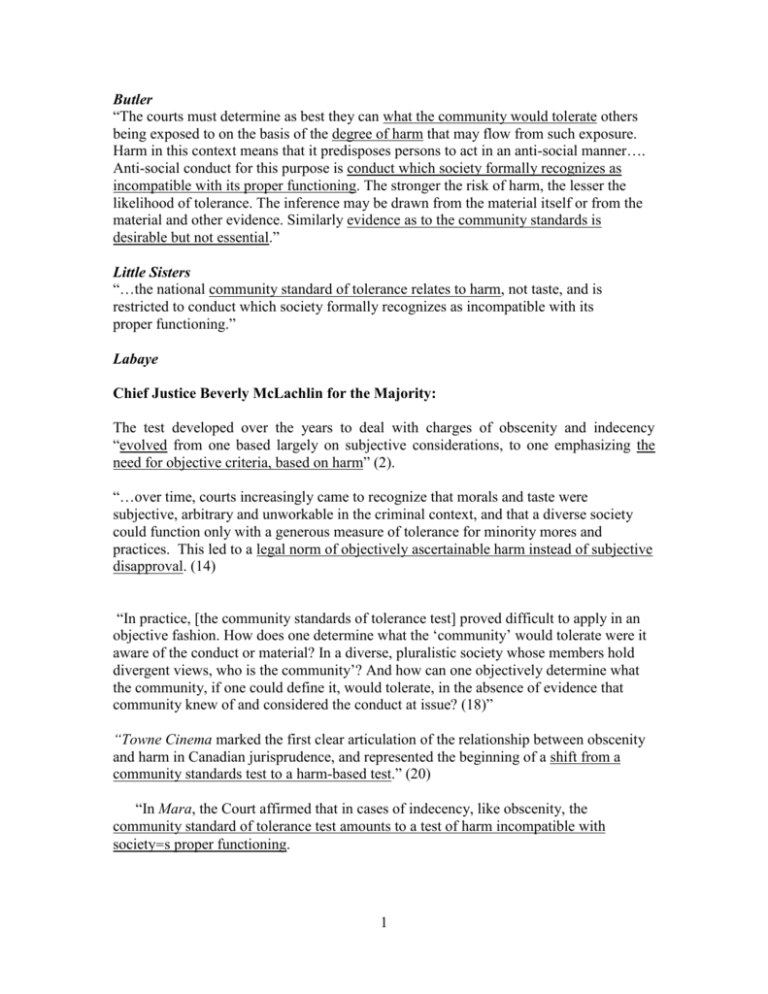
Butler
“The courts must determine as best they can what the community would tolerate others
being exposed to on the basis of the degree of harm that may flow from such exposure.
Harm in this context means that it predisposes persons to act in an anti-social manner….
Anti-social conduct for this purpose is conduct which society formally recognizes as
incompatible with its proper functioning. The stronger the risk of harm, the lesser the
likelihood of tolerance. The inference may be drawn from the material itself or from the
material and other evidence. Similarly evidence as to the community standards is
desirable but not essential.”
Little Sisters
“…the national community standard of tolerance relates to harm, not taste, and is
restricted to conduct which society formally recognizes as incompatible with its
proper functioning.”
Labaye
Chief Justice Beverly McLachlin for the Majority:
The test developed over the years to deal with charges of obscenity and indecency
“evolved from one based largely on subjective considerations, to one emphasizing the
need for objective criteria, based on harm” (2).
“…over time, courts increasingly came to recognize that morals and taste were
subjective, arbitrary and unworkable in the criminal context, and that a diverse society
could function only with a generous measure of tolerance for minority mores and
practices. This led to a legal norm of objectively ascertainable harm instead of subjective
disapproval. (14)
“In practice, [the community standards of tolerance test] proved difficult to apply in an
objective fashion. How does one determine what the ‘community’ would tolerate were it
aware of the conduct or material? In a diverse, pluralistic society whose members hold
divergent views, who is the community’? And how can one objectively determine what
the community, if one could define it, would tolerate, in the absence of evidence that
community knew of and considered the conduct at issue? (18)”
“Towne Cinema marked the first clear articulation of the relationship between obscenity
and harm in Canadian jurisprudence, and represented the beginning of a shift from a
community standards test to a harm-based test.” (20)
“In Mara, the Court affirmed that in cases of indecency, like obscenity, the
community standard of tolerance test amounts to a test of harm incompatible with
society=s proper functioning.
1
Question – Consider:
A.
“…shift from a community standards test to a harm-based test.”
B.
“…community standard of tolerance test amounts to a test of harm
incompatible with society=s proper functioning.”
Are A and B compatible?
“ Grounding criminal indecency in harm represents an important advance in this difficult
area of the law. Harm or significant risk of harm is easier to prove than a community
standard.” (23-4)
“The first step is to generically describe the type of harm targeted by the concept of
indecent conduct under the Criminal Code. In Butler and Little Sisters, this was
described as Aconduct which society formally recognizes as incompatible with its proper
functioning@. (28)
“The requirement of formal societal recognition makes the test objective. The inquiry is
not based on individual notions of harm, nor on the teachings of a particular ideology, but
on what society, through its fundamental laws, has recognized as essential. Views about
the harm that the sexual conduct at issue may produce, however widely held, do not
suffice to ground a conviction…to ground a finding that acts are indecent, the harm must
be shown to be related to a fundamental value reflected in our society=s Constitution or
similar fundamental laws, like bills of rights, which constitutes society=s formal
recognition that harm of the sort envisaged may be incompatible with its proper
functioning. Unlike the community standard of tolerance test, the requirement of formal
recognition inspires confidence that the values upheld by judges and jurors are truly those
of Canadian society. Autonomy, liberty, equality and human dignity are among these
values.” (33)
“Three types of harm have thus far emerged from the jurisprudence as being capable of
supporting a finding of indecency: (1) harm to those whose autonomy and liberty may be
restricted by being confronted with inappropriate conduct; (2) harm to society by
predisposing others to anti-social conduct; and (3) harm to individuals participating in the
conduct. Each of these types of harm is grounded in values recognized by our
Constitution and similar fundamental laws. (36)
“Bad taste does not suffice: Towne Cinema, p. 507. Moral views, even if strongly held,
do not suffice. Similarly, the fact that most members of the community might disapprove
of the conduct does not suffice: Butler, p 492. In each case, more is required to establish
the necessary harm for criminal indecency.” (37)
2
“…the task is to examine the degree of the harm to determine whether it is incompatible
with the proper functioning of society. The threshold is high. It proclaims that as
members of a diverse society, we must be prepared to tolerate conduct of which we
disapprove, short of conduct that can be objectively shown beyond a reasonable doubt to
interfere with the proper functioning of society.” (52)
“If the harm is based on predisposing others to anti-social behaviour, a real risk that the
conduct will have this effect must be proved. Vague generalizations that the sexual
conduct at issue will lead to attitudinal changes and hence anti-social behaviour will not
suffice. The causal link between images of sexuality and anti-social behaviour cannot be
assumed. Attitudes in themselves are not crimes, however deviant they may be or
disgusting they may appear. What is required is proof of links, first between the sexual
conduct at issue and the formation of negative attitudes, and second between those
attitudes and real risk of anti-social behaviour.” (58)
Question: Repudiation of Butler and Parliament’s entitlement to “a reasoned
apprehension of harm?”
Perhaps not.
“Risk is a relative concept. The more extreme the nature of the harm, the lower the
degree of risk that may be required to permit use of the ultimate sanction of criminal law.
Sometimes, a small risk can be said to be incompatible with the proper functioning of
society. For example, the risk of a terrorist attack, although small, might be so
devastating in potential impact that using the criminal law to counter the risk might be
appropriate. However, in most cases, the nature of the harm engendered by sexual
conduct will require at least a probability that the risk will develop to justify convicting
and imprisoning those engaged in or facilitating the conduct.” (61)
Questions:
What is meant by “at least a probability?”
More probable than not?
Was that standard met in Butler?
If not, would the Court now have decided differently?
Or is obscene pornography closer to terrorism than swinging? Plausible?
3
Summary of the LABAYE Test
“Indecent criminal conduct will be established where the Crown proves beyond a
reasonable doubt the following two requirements:
“1. That, by its nature, the conduct at issue causes harm or presents a significant risk of
harm to individuals or society in a way that undermines or threatens to undermine a value
reflected in and thus formally endorsed through the Constitution or similar fundamental
laws by, for example:
(a) confronting members of the public with conduct that significantly
interferes with their autonomy and liberty; or
(b) predisposing others to anti-social behaviour; or
(c) physically or psychologically harming persons involved in the conduct,
and
2.
That the harm or risk of harm is of a degree that is incompatible with the
proper functioning of society.
As the above makes clear, the categories of harm capable of satisfying the first branch of
the inquiry are not closed…” (62)
4
Application of the Test:
1.
No evidence of first type of harm (a); steps taken to conduct activities behind
closed doors;
2.
No “evidence of the second type of harm, the harm of predisposing people to
anti-social acts or attitudes. Unlike the material at issue in Butler, which
perpetuated abusive and humiliating stereotypes of women as objects of
sexual gratification, there is no evidence of anti-social attitudes toward
women, or for that matter men.” (67)
True? Attitudes of non-participants not affected. But what about attitudes of
participants who then interact with others? Encourages “objectification” of
others – women in particular – with whom participants interact once they leave
the premises? Third party effects?
3.
“…no evidence of the third type of harm B physical or psychological harm to
persons participating. The only possible danger to participants on the
evidence was the risk of catching a sexually transmitted disease. However,
this must be discounted as a factor because, as discussed above, it is
conceptually and causally unrelated to indecency.” (68)
5
Conclusions:
1.
“no other harms are raised by the evidence in this case. All that is raised, in
the final analysis, is the assessment that the conduct amounted to Aan orgy@
and that Canadian society does not tolerate orgies. This reasoning erroneously
harks back to the community standard of tolerance test, which has been
replaced, as discussed, by the harm-based test developed in Butler.” (69)
2.
“It is unnecessary to proceed to the second branch of the test. However, if one
did, there appears to be no evidence that the degree of alleged harm rose to the
level of incompatibility with the proper functioning of society. Consensual
conduct behind code-locked doors can hardly be supposed to jeopardize a
society as vigorous and tolerant as Canadian society.” (71)
3.
“I would allow the appeal and set aside the conviction.” (72)
Bastarache and Lebel for the Minority:
“Our colleagues= approach replaces the community standard of tolerance with a test that
treats harm as the basis of indecency rather than as a criterion for determining the
community=s level of tolerance. Whether or not serious social harm is sustained has
never been the determinative test for indecency, and it cannot take the place of a
contextual analysis of the Canadian community standard of tolerance without completely
transforming the concept of indecency and rendering it meaningless.” (75)
6
“In our opinion, there is a single question that must be asked to find that acts are indecent
and to determine whether a place constitutes a common bawdy-house: ADo the
impugned acts offend the standard of tolerance of the contemporary Canadian
community, having regard to the place and context in which they occurred?@ (81)
“The general Canadian community standard of tolerance has become the fundamental test
for establishing obscenity. The standard has been applied or cited consistently and
uniformly in cases subsequent to Brodie...” (91)
“…applying [the standard of tolerance] necessarily entails a choice of values that relate to
social or public morality and are recognized by the entire Canadian community as
minimum, but mandatory, standards. The standard of tolerance does not impose a
morality based on particular religious beliefs or particular ideologies. It implements a
social morality that is the product of values characteristic of the entire community.” (85)
“…it is necessary to establish the degree of tolerance of the majority of the Canadian
community as a whole toward sexual acts, taking their context, including the place where
they occur, into account. The test for indecency thus remains sufficiently objective,
because it is based on a social consensus among Canadians as to what is acceptable in
terms of sexual practices.” (85)
“Judges called upon to determine the standard of tolerance may therefore rely on
principles of social morality drawn from legislation. Parliament has given effect to these
principles by enacting statutory provisions banning such acts as child pornography or
incest. It has also prohibited acts that constitute transgressions of social morality in the
context and in the places in which they are performed. Thus, acts that encourage the
7
exploitation of women, the exchange of sexual favours for money, and sexual violence
offend against social morality… These factors are indicia upon which judges may rely to
reach a finding of indecency, since they are indicators of the level of tolerance of the
community as a whole.” (88)
“…despite the importance of the social harm test, it cannot be said to be the only standard
by which the tolerance of the Canadian community for sexual practices is to be
measured.” (96)
“Harm is but one indicator of the community standard of tolerance. “ (97)
“Furthermore, the existence of harm is not a prerequisite for exercising the state=s power
to criminalize certain conduct. The existence of fundamental social and ethical
considerations is sufficient.” (104)
“According to contemporary Canadian social morality, acts such as child pornography,
incest, polygamy and bestiality are unacceptable regardless of whether or not they cause
social harm. The community considers these acts to be harmful in themselves.” (109)
“In principle, we consider the change to the legal order proposed by the majority to be
inappropriate, particularly because no valid justification is given for departing from the
existing test. We are convinced that this new approach strips of all relevance the social
values that the Canadian community as a whole believes should be protected.” (98)
8
Minority Conclusion re: Validity of Labaye Test for Obscenity:
“In our opinion, the test adopted by the majority introduces a concept of tolerance that
does not seem to be justifiable according to any principle whatsoever. This concept
cannot be accepted on the pretext that harm is easier to prove or that it is desirable for
this type of offence to have the same rationale as the vast majority of other criminal
offences, namely the need to protect the community from harm. Social morality, which
is inherent in indecency offences and is expressed through the application of the standard
of tolerance, must still be allowed to play a role in all situations where it is relevant.
Otherwise, the social values that the Canadian community as a whole considers worth
protecting would be stripped of any relevance.” (103)
Question 1 : Rejecting liberalism of Mill and Hart; Accepting legal moralism of
Devlin?
Question 2: Is the Minority correct that the Majority had (with no good legal or
moral reason) replaced the Community Standards Test with the Harm Test?
Question 3: The Minority claims that polygamy and incest are “harmful in
themselves.” Does this make sense? Should they have said: “Wrong in and of
themselves independently of any harmful consequences”? Is harm by its nature
always a consequence or effect?
Question 4: Is the Minority, like the Majority, playing fast and loose with the notion
of “harm”? Are they perhaps doing this so as to remain, at least tacitly, within the
spirit of the Harm Principle? Indecency, they seem to be claiming, is “socially
9
harmful” because it violates social morality of the community – as Devlin might
have said. Is this a fair take on the Minority view? C.F. MacLachlin’s apparent
attempt – with her notion of “in-your-face indecency” – to smuggle Offence in as a
ground of criminal regulation. Recall her claim that this is a kind of harm – the
second of her three relevant types. Is the concept of harm as elastic as both the
Majority and the Minority seem to be supposing? Might it not be better to recognize
that Harm is not really the ONLY basis for intervention via the law – perhaps even
the criminal law – as the Minority seems at times to suggest??
The Minority’s “Context-Based Standard of Tolerance” (116)
“It can be seen from this Court=s case law on indecency and obscenity that
the following contextual factors may be taken into consideration in determining the
standard of tolerance:
(1) the private or public nature of the place;
(2) the type of participants and the composition of the audience;
(3) the nature of the warning given regarding the acts;
(4) the measures taken to limit access to the place;
(5) the commercial nature of the place and the acts;
(6) the purpose of the acts;
(7) the conduct of the participants; and
(8) harm [physical or psychological] suffered by the participants.” (122)
“This list is not exhaustive.” (122)
10
“A consensual sexual act that is totally acceptable in one situation may be indecent if it
is performed in another context. It is the tolerance of the general public that counts, not
the tolerance of the participants or spectators.” (132)
Minority’s Application of Test:
“In the case at bar, we find that the sexual acts in issue were indecent, given their context.
In our opinion, the community does not tolerate the performance of acts of this nature in
a place of business to which the public has easy access. The appellant=s establishment
was therefore a common bawdy-house.” (137)
Reasons?
1.
“…this was a place with a decidedly public character.” (142)
True? Majority thought otherwise.
2.
“this is a case involving informed adults who presumably shared the
philosophy of partner swapping. However, this characteristic of the
participants is not relevant…other than to demonstrate the existence of
degrading or dehumanizing acts.” (145)
True? Majority stressed fact of consenting adults.
3.
“The participants essentially purchased sexual services provided by other
participants…” (148)
True? Purchase of sexual services? Or purchase of right to enter private
establishment where consensual, non-commercial sexual activities occurred?
Parallel with paying for hotel room?
11
4.
“In the instant case, it is still possible to conclude that a form of social harm
has been sustained that indicates that the level of tolerance of Canadians has
been exceeded. This harm results from the failure to meet the minimum
standards of public morality rather than from incompatibility with the Aproper
functioning of society@ or from predisposing others to anti-social behaviour.”
(151)
Question: Is this form of “social harm” anything more than what Mill called
“constructive injury.”
Minority’s Main Conclusion:
“In the case at bar, the impugned sexual acts were very explicit acts, and they took place
in a commercial establishment that was easily accessible to the general public. This
situation caused a certain form of social harm resulting from the failure to meet the
minimum standards of public morality. In light of these contextual factors, we are of the
opinion that the sexual acts performed in the appellant=s establishment clearly offended
the Canadian community standard of tolerance and were therefore indecent. Our analysis
does not permit us to conclude that the Canadian community would tolerate the
performance, in a commercial establishment to which the public has easy access, of
group sexual activities on the scale of those that took place in this case. The appellant=s
establishment is therefore a common bawdy-house within the meaning of s. 210(1) Cr. C.
We would have dismissed the appeal and upheld the appellant=s conviction.” (153-4)
12
13


